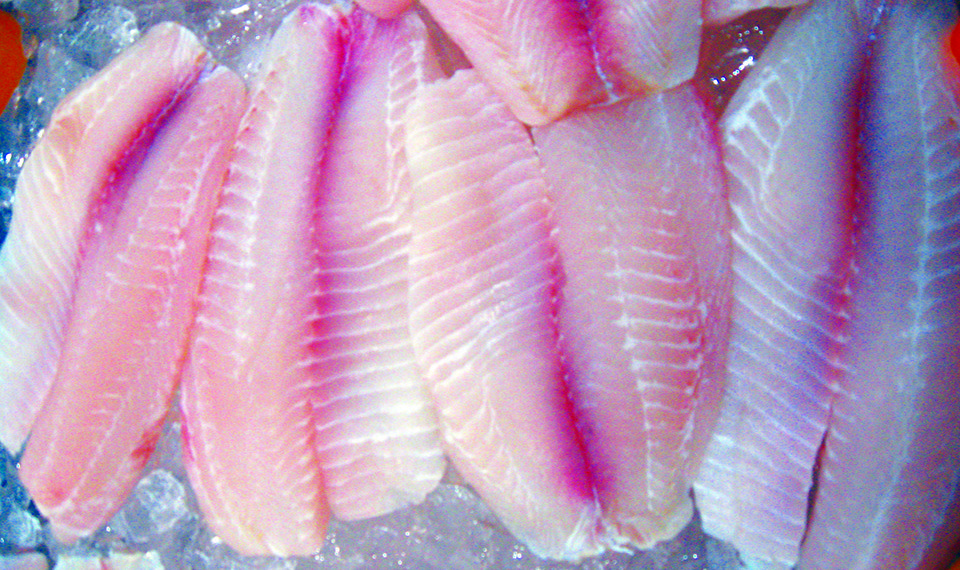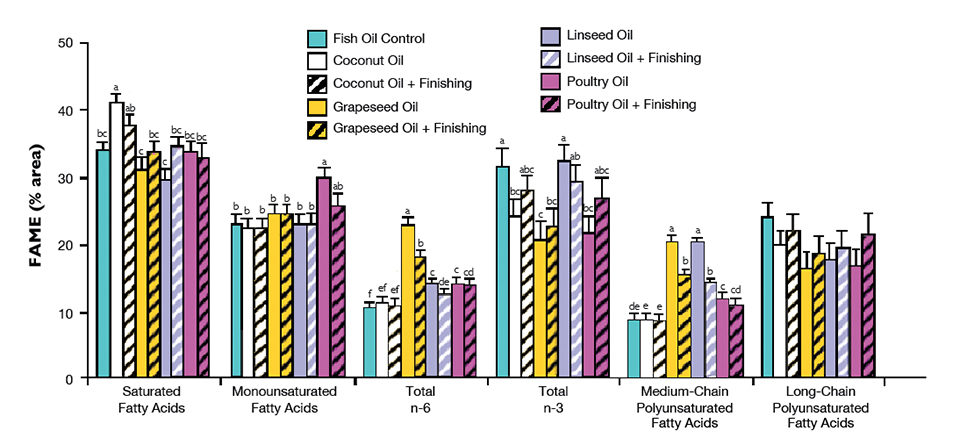Wholesale conversion to alternative formulations compromises nutritional value

Historically, aquafeeds were comprised largely of marine-derived ingredients such as fishmeal and fish oil. The rising cost of these products and public pressure from environmental and human food safety groups have created incentives to reformulate aquafeeds with greater levels of alternative proteins, fats and oils.
In a recent State of World Fisheries and Aquaculture report, the Food and Agriculture Organization concluded: “Given the difficulty in replacing fish oils … it is clear that competition for fish oil is likely to be a more serious obstacle for some sections of the aquaculture industry.” While direct fishmeal replacement has also proven difficult, fish oil replacement is considered more difficult, in part because alternative sources of the nutrients found in fish oil are lacking. The essential amino acids in fishmeal are ubiquitous, albeit not always in the desired proportions. The essential fatty acids found in fish oil are not so abundant.
Fish oil in aquaculture
Fish oil contains high levels of long-chain polyunsaturated fatty acids (LC-PUFAs), such as eicosapentaenoic acid and docosahexaenoic acid, which are known to have positive impacts on a variety of human health disorders and conditions. Excluding specialty oils derived from algal or fungal cultures, fish oil alternatives contain, at most, trace levels of these nutrients.
Because the fatty acid composition of fish tissue is influenced by dietary fatty acid profile, fillets of fish raised on feeds with reduced or no fish oil contain substantially lower levels of beneficial LC-PUFAs. Herein lies the conflict: The need to reduce reliance on fish oil is clear, but none of the commercially viable alternatives provide equivalent levels of LC-PUFAs, and wholesale conversion to alternative formulations compromises the nutritional value of farm-raised seafood.
Finishing strategies
To reduce fish oil use while maintaining product quality, producers can use “finishing” strategies to restore fillet LC-PUFA content in fish raised on alternative feeds. Finishing strategies divide the production cycle into growout and finishing periods, which utilize different feeds.
During grow-out, fish are fed alternative fat- or oil-based feeds. At a predetermined time before harvest, they are switched to a fish oil-based feed for finishing and restoration of fillet fatty acid profile.
Finishing strategies have been used to improve fillet quality in a number of fish. However, the extent of LC-PUFA enrichment achieved varies. The authors have noted greater finishing success in hybrid striped bass when the growout feed contained higher levels of saturated and monounsaturated fatty acids (SFAs and MUFAs), typically associated with animal fats and certain plant oils, as opposed to the medium-chain polyunsaturated fatty acids (MC-PUFAs) typically associated with grains and oilseeds.
Grow-out trial
In order to determine whether this was also the case for Nile tilapia, the authors assessed finishing success among Oreochromis niloticus raised on grow-out feeds containing a 50/50 blend of fish oil and poultry (MUFA-rich), linseed (n-3 MC-PUFA-rich), grapeseed (n-6 MC-PUFA-rich) or coconut (SFA-rich) oils.
Replicate tanks of tilapia were raised in a recirculation system for 11 weeks, after which half of the tanks within each dietary group were switched to a 100 percent fish oil based feed for four weeks of finishing. The remaining tanks were kept on their assigned, reduced fish oil-feeds for the rest of the trial. A control group of fish was raised exclusively on the 100 percent fish oil feed.
Finishing success
After 15 weeks of culture, the mean survival (95 ± 3 percent), weight gain (205 grams ± 8 percent), feed-conversion ratio (1.9 ± 0.1) and dress-out (87.6 ± 0.3 percent, eviscerated carcass) of the tilapia were unaffected by the various feeding strategies, indicating this species could effectively utilize coconut, linseed, grapeseed, poultry and fish oils. Feeding the alternative oils resulted in the accumulation of their constitutive fatty acids within the fillets, particularly MUFAs and MC-PUFAs (Fig. 1).

These departures from a fish oil-associated profile were largely corrected by finishing, but profile restoration was most complete among fish fed the coconut and poultry oil-based feeds during grow-out. Although differences were not significant in all cases, levels of fish oil-associated fatty acids were elevated among finished groups relative to their unfinished counterparts.
Perspectives
A number of issues may have contributed to the authors’ inability to resolve statistical significance for all the fatty acids and fatty acid groupings. First, they observed a high level of individual-to-individual variation in this study, likely because of the errant reproduction that occurred during the feeding trial. Additional lipid nutrition studies using all-male populations of Nile tilapia are currently under way to address this issue.
Second, fillet levels of LC-PUFAs were relatively well maintained regardless of feeding strategy, which may have weakened the influence of finishing on LC-PUFA augmentation. This suggested Nile tilapia have considerable ability to synthesize LC-PUFAs from shorter-chain fatty acid precursors and/or conserve LC-PUFAs within their tissues when dietary levels are reduced. Further research is needed to address these issues.
Editor’s Note: This article was based on a paper by the authors recently published in the North American Journal of Aquaculture: “Influence of grow-out feed fatty acid composition on finishing success in Nile tilapia.”
(Editor’s Note: This article was originally published in the September/October 2009 print edition of the Global Aquaculture Advocate.)
Now that you've finished reading the article ...
… we hope you’ll consider supporting our mission to document the evolution of the global aquaculture industry and share our vast network of contributors’ expansive knowledge every week.
By becoming a Global Seafood Alliance member, you’re ensuring that all of the pre-competitive work we do through member benefits, resources and events can continue. Individual membership costs just $50 a year. GSA individual and corporate members receive complimentary access to a series of GOAL virtual events beginning in April. Join now.
Not a GSA member? Join us.
Authors
-
Jesse T. Trushenski, Ph.D.
Fisheries and Illinois Aquaculture Center
Department of Zoology
Southern Illinois University Carbondale
Carbondale, Illinois 62901-6511 USA -
John Boesenberg
Fisheries and Illinois Aquaculture Center
Department of Zoology
Southern Illinois University Carbondale
Carbondale, Illinois 62901-6511 USA -
Christopher C. Kohler, Ph.D.
Fisheries and Illinois Aquaculture Center
Department of Zoology
Southern Illinois University Carbondale
Carbondale, Illinois 62901-6511 USA
Tagged With
Related Posts

Intelligence
A brief look at genetically modified salmon
If approved by FDA, fast-growing genetically modified salmon will provide a safe and nutritious product similar to other farmed Atlantic salmon.

Aquafeeds
A look at phospholipids in aquafeeds
Phospholipids are the major constituents of cell membranes and are vital to the normal function of every cell and organ. The inclusion of phospholipids in aquafeeds ensures increased growth, better survival and stress resistance, and prevention of skeletal deformities of larval and juvenile stages of fish and shellfish species.

Aquafeeds
A new nutrient for aquaculture, from microbes that consume carbon waste
Biotechnology firm NovoNutrients aims to produce a line of nutraceutical aquafeed additives as well as a bulk feed ingredient that can supplement fishmeal. Its process includes feeding carbon dioxide from industrial gas to a “microbial consortium” starring hydrogen-oxidizing bacteria.

Health & Welfare
Acclimating shrimp postlarvae before pond stocking
Shrimp postlarvae acclimation before stocking into the various growout systems (ponds, raceways, tanks) is a critical – and often overlooked, sometimes taken for granted – step in the shrimp culture process. Various water quality parameters should be changed slowly so that the young shrimp have the time to gradually adapt to the new conditions.


